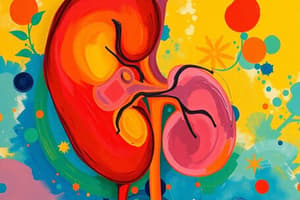Podcast
Questions and Answers
What is the primary consequence of electrolyte imbalance in the body?
What is the primary consequence of electrolyte imbalance in the body?
- Improvement in organ function
- Disruption of cellular metabolism (correct)
- Accelerated healing process
- Enhanced immune response
How can sodium levels become imbalanced?
How can sodium levels become imbalanced?
- Elevated phosphate levels
- Increased potassium intake
- High calcium levels
- Excessive sweating (correct)
What is the role of buffers in maintaining physiological pH?
What is the role of buffers in maintaining physiological pH?
- They produce hormones
- They help regulate temperature
- They enhance oxygen transport
- They neutralize acids and bases (correct)
Which condition is associated with hypovolemia?
Which condition is associated with hypovolemia?
What is an effect of metabolic acidosis on the body?
What is an effect of metabolic acidosis on the body?
Which term describes a solution with lower solute concentration compared to the cell?
Which term describes a solution with lower solute concentration compared to the cell?
What physiological change occurs during impaired diffusion?
What physiological change occurs during impaired diffusion?
What condition can lead to hyperkalemia?
What condition can lead to hyperkalemia?
How does body regulate fluid intake and excretion?
How does body regulate fluid intake and excretion?
What is a common effect of impaired ventilation and diffusion?
What is a common effect of impaired ventilation and diffusion?
Which condition is characterized by impaired ventilation due to obstructed airflow?
Which condition is characterized by impaired ventilation due to obstructed airflow?
Which of the following best describes the pathway from ventilation to perfusion?
Which of the following best describes the pathway from ventilation to perfusion?
What diagnostic tool is commonly used to assess impaired diffusion in the lungs?
What diagnostic tool is commonly used to assess impaired diffusion in the lungs?
Which of the following is NOT a clinical model related to altered perfusion?
Which of the following is NOT a clinical model related to altered perfusion?
What is the role of neural control in the functioning of the heart?
What is the role of neural control in the functioning of the heart?
How does impaired circulation relate to altered perfusion?
How does impaired circulation relate to altered perfusion?
Which condition directly results from altered cardiac output?
Which condition directly results from altered cardiac output?
Flashcards
Normal Electrolyte Values
Normal Electrolyte Values
The normal levels of electrolytes in the fluid outside of cells (extracellular fluid), like sodium, potassium, chloride, calcium, and magnesium.
Electrolyte Functions
Electrolyte Functions
Electrolytes maintain fluid balance, nerve impulses, muscle contractions, blood clotting, and bone health.
Causes of Electrolyte Imbalance
Causes of Electrolyte Imbalance
Disruptions in fluid balance can occur due to factors like vomiting, diarrhea, diuretics, renal failure, thyroid disorders, burns, kidney failure, and sepsis.
Osmosis
Osmosis
The movement of water across a cell membrane to equalize the concentration of solutes on both sides.
Signup and view all the flashcards
Homeostasis
Homeostasis
Maintaining a stable internal environment, including pH and electrolyte balance, within a narrow range.
Signup and view all the flashcards
Metabolic Acidosis
Metabolic Acidosis
A condition where the body's pH is abnormally low, often caused by an accumulation of acids.
Signup and view all the flashcards
Ventilation
Ventilation
The process of breathing, involving the movement of air into (inspiration) and out of (expiration) the lungs.
Signup and view all the flashcards
Diffusion
Diffusion
The movement of gases across a membrane, from an area of high concentration to low concentration.
Signup and view all the flashcards
Impaired Ventilation and Diffusion
Impaired Ventilation and Diffusion
Conditions that affect the ability of the lungs to exchange oxygen and carbon dioxide effectively.
Signup and view all the flashcards
Ventilation-perfusion Mismatch
Ventilation-perfusion Mismatch
An imbalance between the amount of air entering the lungs (ventilation) and the amount of blood flowing through them (perfusion).
Signup and view all the flashcards
Impaired Diffusion
Impaired Diffusion
A reduction in the rate of gas exchange across the alveolar-capillary membrane, often due to factors like thickening of the membrane or decreased surface area.
Signup and view all the flashcards
From Ventilation to Perfusion
From Ventilation to Perfusion
The pathway from ventilation to perfusion involves moving oxygen from the air we breathe into the bloodstream and transporting it throughout the body, while simultaneously removing carbon dioxide from the blood and expelling it.
Signup and view all the flashcards
The Circulatory System
The Circulatory System
The circulatory system includes the heart, blood vessels, and blood. It's responsible for carrying oxygen, nutrients, and waste products throughout the body.
Signup and view all the flashcards
Impaired Circulation
Impaired Circulation
A condition where blood flow through the body is significantly reduced, leading to insufficient oxygen delivery to tissues. This can be caused by various factors such as heart failure, shock, or severe dehydration.
Signup and view all the flashcards
Cardiac Output
Cardiac Output
The amount of blood pumped by the heart per minute. It's a crucial indicator of the heart's ability to effectively circulate blood.
Signup and view all the flashcards
Neural Control of Blood Pressure
Neural Control of Blood Pressure
The body's ability to regulate blood pressure is influenced by the nervous system. Signals from the brain control heart rate, blood vessel constriction, and other factors to maintain appropriate blood pressure.
Signup and view all the flashcards
Altered Perfusion: Clinical Models
Altered Perfusion: Clinical Models
Conditions like hypertension (high blood pressure), shock (decreased blood flow), heart failure (inability of the heart to pump effectively), myocardial infarction (heart attack), and stroke (damage to the brain from blood clot or bleeding) all involve alterations in perfusion, affecting how blood flows through the body and delivers oxygen to tissues.
Signup and view all the flashcardsStudy Notes
Fluid and Electrolyte Balance (Ch 8)
- Electrolyte Values (Normal): Expected levels of extracellular electrolytes are referenced in Figure 8.1.
- Electrolyte Functions & Imbalances: Electrolytes have vital bodily functions. Imbalances cause various effects (Table 8.1). Sodium loss is from vomiting, diarrhea, or sweating. Potassium loss is from diuretics, severe vomiting, or diarrhea. Renal failure causes hyperkalemia. Hypocalcemia may result from thyroid disorders, severe burns, kidney failure, vitamin D deficiency, and sepsis, alongside other factors.
- Fluid Distribution: Body fluids are located in various compartments. Fluid movement between cells and tissues, as well as in and out of circulation (blood vessels and nephrons) is crucial.
- Fluid Regulation: The body regulates fluid intake and output through intricate mechanisms.
- Tonicity: Isotonic, hypertonic, and hypotonic fluids have different effects on cell volume depending on their concentration of solutes.
- Altered Fluid Balance: Conditions like hypovolemia (low blood volume), hemorrhage, dehydration, water intoxication, hypervolemia (high blood volume), and edema are examples of altered fluid balance.
Acid-Base Balance (Ch 9)
- Physiological pH: The body maintains a specific pH range in the blood.
- Importance of pH: A critical range must be maintained for optimal cellular and tissue function. Deviation from this range can have adverse consequences.
- Buffer Systems: There are 3 buffer systems in the body – bicarbonate, phosphate, and protein – to regulate pH through complex chemical reactions.
Altered Ventilation and Diffusion (Ch 15)
- Ventilation and Diffusion: The process of breathing (inspiration and expiration), gas exchange (partial pressures of O2 and CO2), and transportation of these gases in the blood are essential components of respiratory function.
- Impaired Ventilation and Diffusion: This can lead to hypoxemia (low blood oxygen), hypoxia (reduced tissue oxygen), and hypercapnia (high blood CO2) with accompanying symptoms.
- Ventilation-Perfusion Mismatch: Uneven distribution of air in the lungs and blood flow impacts gas exchange.
- Altered Diffusion: Issues with the exchange of gases across the alveoli and capillaries can compromise oxygenation and CO2 removal.
- Measuring and Treating: Methods to assess and treat impaired ventilation and diffusion (e.g. lab tests and therapies) are addressed in this chapter.
- Clinical Models: Chronic obstructive pulmonary disease (COPD) including emphysema, chronic bronchitis, asthma, and cystic fibrosis are outlined as examples of conditions associated with impaired ventilation and diffusion.
Altered Perfusion (Ch 16)
- Perfusion: Vital for delivering oxygen and nutrients to tissues.
- Circulatory Pathways: Understand the pulmonary and systemic circulatory systems, and the specific path of blood flow, including the heart's function.
- Cardiac Cycle & Electrical Impulses: Explains the mechanical and electrical functioning of the heart.
- Cardiac Output: The heart's pumping capacity.
- Neural Control: The nervous system regulates the heart's rate and blood pressure.
- Altered Perfusion: Conditions leading to problems with blood flow, including ventilation-perfusion mismatch, decreased cardiac output and changes in perfusion needs.
- Diagnosis & Treatment: This discussion involves examining the manifestations of impaired perfusion, using lab tests, and implementing appropriate treatments.
- Clinical Models: This chapter explores the clinical contexts of hypertension (high blood pressure), shock, myocardial infarction, heart failure, and stroke. Other key conditions covered are cirrhosis and dehydration.
Exam 2 Diagnoses (Clinical Models)
- COPD (Emphysema, Chronic Bronchitis)
- Asthma
- Cystic Fibrosis
- Hypertension
- Stroke
- Shock
- Heart Failure
- Myocardial Infarction
- Cirrhosis
- Dehydration
- Metabolic Acidosis
Studying That Suits You
Use AI to generate personalized quizzes and flashcards to suit your learning preferences.




